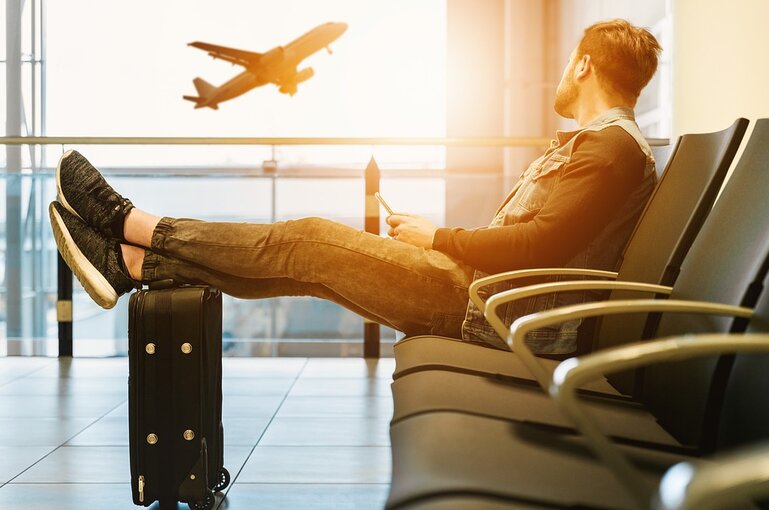In this comprehensive guide, we’ll explore the topic of fear of flying therapy, its benefits, and how to find flying phobia treatment near you. Many individuals suffer from the fear of flying, but with the right therapy and techniques, you can conquer your apprehensions and soar the skies with confidence. In this blog, we will explore the root causes of the fear of flying, the various therapy options available, and the steps you can take to overcome this anxiety.
Contents
Understanding the Fear of Flying

The fear of flying can stem from various sources, including past traumatic experiences, fear of heights, or a lack of control. Understanding the underlying causes is crucial to effective therapy.
Learn to identify the signs of fear of flying, from pre-flight jitters to full-blown panic attacks. Recognizing these symptoms is the first step toward addressing them.
Discover just how prevalent the fear of flying is and why you are not alone in your struggle.
Types of Fear of Flying Therapy
Overcoming the fear of flying, or aviophobia, is achievable through various types of therapy and interventions. These therapies aim to address the root causes of fear and equip individuals with coping mechanisms to manage their anxiety when flying. Here are some common types of fear of flying therapy:
- Cognitive-Behavioral Therapy (CBT): CBT is a widely used and effective therapeutic approach for treating phobias, including the fear of flying. In CBT, individuals work with a therapist to identify and challenge irrational thoughts and beliefs related to flying. Through this process, they learn to replace negative thought patterns with more realistic and positive ones. CBT also involves gradual exposure to flying-related stimuli to desensitize the individual to their fear.
- Exposure Therapy: Exposure therapy is a behavior-based approach that involves gradually and systematically exposing individuals to the source of their fear—in this case, flying. The exposure is carefully controlled, starting with less anxiety-inducing situations (e.g., looking at pictures of airplanes) and progressing to more challenging scenarios (e.g., sitting in a grounded airplane or taking short flights). Over time, repeated exposure helps individuals become more comfortable with flying.
- Virtual Reality (VR) Therapy: VR therapy offers a high-tech approach to fear of flying treatment. Individuals are immersed in a computer-generated virtual environment that simulates the experience of flying. This technology can replicate various aspects of air travel, such as takeoff, turbulence, and landing. VR therapy allows individuals to confront their fear in a controlled setting, helping them become more accustomed to flying without actually boarding a plane.
- Hypnotherapy: Hypnotherapy aims to access and address the subconscious triggers of the fear of flying. During a hypnotherapy session, individuals enter a state of deep relaxation and heightened suggestibility. A trained therapist then guides them through relaxation techniques and suggests positive and calming thoughts related to flying. Hypnotherapy can be a complementary approach to other therapeutic methods.
- Group Therapy: Group therapy sessions bring together individuals who share a fear of flying. Led by a therapist with expertise in aviation phobias, these sessions provide a supportive environment where participants can share their experiences, fears, and coping strategies. Group therapy can help individuals realize they are not alone in their struggle and gain insights from others’ journeys.
Benefits of Fear of Flying Therapy

Fear of flying therapy offers numerous benefits to individuals struggling with aviophobia, or the fear of flying. These therapeutic interventions are designed to help individuals overcome their anxiety and gain confidence in air travel. Here are some of the key benefits of fear of flying therapy:
- Improved Quality of Life: One of the most significant benefits of fear of flying therapy is an improved overall quality of life. Aviophobia can limit individuals’ opportunities for travel and adventure, both personally and professionally. Overcoming this fear allows them to explore new destinations, visit loved ones, and pursue career opportunities that may involve air travel.
- Reduced Anxiety: Fear of flying can trigger intense anxiety and panic attacks, even at the thought of taking a flight. Therapy provides individuals with tools and coping strategies to manage their anxiety effectively. As a result, they can experience reduced levels of anxiety, both during the flight and in anticipation of it.
- Increased Confidence: Fear of flying therapy helps individuals build confidence in their ability to cope with their fear. By learning about the safety measures in place, understanding the mechanics of flight, and practicing relaxation techniques, individuals become more self-assured and capable of facing their fear head-on.
- Enhanced Safety Awareness: Fear of flying therapy often includes education about aviation safety and procedures. This knowledge helps individuals feel more in control and reassured during flights, as they understand the precautions and protocols in place to ensure their safety.
- Overcoming Avoidance Behavior: Many individuals with aviophobia resort to avoiding air travel altogether. This avoidance behavior can limit their personal and professional growth. Therapy helps individuals confront their fear, gradually reintroducing them to flying and reducing the need for avoidance.
- Better Emotional Well-Being: Overcoming a phobia can have a positive impact on an individual’s emotional well-being. As they conquer their fear of flying, they often experience a sense of accomplishment, reduced stress, and improved self-esteem.
Finding Fear of Flying Therapy Near Me
Finding fear of flying therapy near you involves several steps to identify qualified therapists or programs that specialize in treating aviophobia. Here’s a step-by-step guide to help you find fear of flying therapy options in your area:
- Consult with Your Primary Care Physician: Start by speaking with your primary care physician or a mental health professional. They can provide recommendations, assess your needs, and potentially refer you to specialists or therapists who specialize in treating aviophobia.
- Contact Local Mental Health Associations: Reach out to your local or state mental health associations or chapters of professional organizations like the American Psychological Association or the American Counseling Association. They may have directories or resources to help you find therapists specializing in phobias and anxiety.
- Ask for Recommendations: Seek recommendations from friends, family members, or colleagues who have experience with therapy or have overcome their fear of flying. Personal referrals can be valuable in finding a therapist who is effective and experienced in treating aviophobia.
- Check with Universities and Hospitals: Universities and teaching hospitals often have psychology or psychiatry departments that offer therapy services to the community. Contact these institutions to inquire about therapists or programs specializing in anxiety disorders and phobias.
- Contact Airlines and Travel-Related Organizations: Some airlines and travel companies offer fear of flying programs or referrals to therapy services. Contact your local airlines or travel agencies to inquire about any available resources or recommendations.
Preparing for Fear of Flying Therapy

Preparing for fear of flying therapy is an important step in your journey to overcome aviophobia. Proper preparation can help you make the most of your therapy sessions and increase the likelihood of successfully conquering your fear. Here are some key steps to consider when preparing for fear of flying therapy:
- Acknowledge Your Fear: Before attending therapy, it’s essential to recognize and accept your fear of flying. Understand that it is a genuine and common anxiety disorder and that seeking help is a positive step toward overcoming it.
- Set Clear Goals: Establish clear and realistic goals for your therapy. Consider what you hope to achieve, whether it’s being able to board a plane without panic, reducing anxiety during flights, or feeling more in control of your fear.
- Gather Information: Educate yourself about the therapy process. Understand the types of therapy available for fear of flying, such as cognitive-behavioral therapy (CBT), exposure therapy, or virtual reality therapy. Knowing what to expect can ease anxiety about the therapy itself.
- Choose the Right Therapist: Take the time to research and select a therapist who specializes in treating phobias and anxiety disorders, particularly the fear of flying. Ensure they are licensed and experienced in this area. A good therapist can make a significant difference in your progress.
- Write Down Your Thoughts and Concerns: Keep a journal or notebook where you can jot down your thoughts, fears, and concerns related to flying. This can be valuable during therapy sessions to identify specific triggers and thought patterns.
- Identify Specific Triggers: Reflect on the specific aspects of flying that trigger your anxiety. Is it turbulence, the sensation of takeoff and landing, or being confined in an aircraft? Identifying these triggers can help your therapist tailor your treatment plan.
- Collect Information on Past Experiences: If you have had previous negative experiences with flying, gather information about them. This can include flight details, what caused your fear during those flights, and how you coped (or didn’t cope) with the anxiety.
What to Expect During Therapy
Here’s what you can generally anticipate during fear of flying therapy:
- Initial Assessment: At the beginning of therapy, your therapist will conduct an initial assessment. This may involve discussing your history, past experiences with flying, specific triggers for your fear, and your goals for therapy. The therapist will also gather information about your overall mental health and well-being.
- Establishing Rapport: Building trust and rapport with your therapist is crucial. Therapy is a collaborative process, and a strong therapeutic relationship can contribute to your progress. Your therapist will create a safe and supportive environment where you can openly discuss your fears.
- Education and Information: Your therapist will likely provide education about the fear of flying, including its common triggers and manifestations. They may also explain the physiology of anxiety and the cognitive processes that contribute to your fear. Understanding the nature of your fear is an essential part of therapy.
Conclusion
Conquering the fear of flying is a journey that begins with a single step. With the right therapy and self-help strategies, you can overcome your fear and experience the joys of air travel. Don’t let fear hold you back—take control and soar the skies with confidence.
If you are looking for an affordable Online Therapy TherapyMantra can help: Book a trial Online therapy session.


